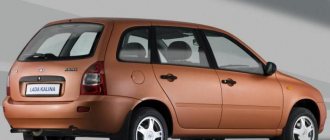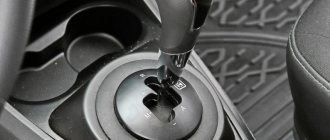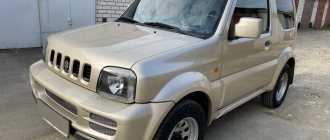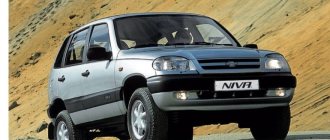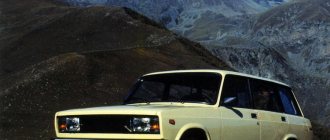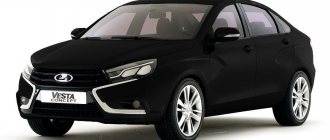Among the whole variety of rear-wheel drive VAZ cars, every true “Zhigulista” has his own favorite model: some like the naively round-headed “penny” cars, others love the more angular cars of the fifth family, others are generally “crazy” for station wagons... However, a significant part of the fans Tolyatti classics are confident that the VAZ-2106 is “the best Zhiguli of all time,” the pinnacle of the rear-wheel drive line of the Volzhsky Automobile Plant. The most varied arguments are given. We will try to put these puzzles together into a single picture, which will help answer yes or no to the question: were the “six” really the best, and why?
Exterior
The exterior of domestic classics in the modern world no longer attracts the attention of passers-by. Although at the end of the last century it was considered the standard of beauty and style. The six does not have graceful body lines; only chopped shapes predominate in it. The front part of the model received a chrome edging around the radiator grille and head optics, consisting of four headlights. In the center of the grille is the manufacturer's emblem. Since the VAZ 2106 became an updated version of the three-ruble car, the basic concept of the car has not changed. Engineers have only slightly reduced the cost of the design by reducing the amount of expensive zinc alloy used to produce some decorative parts.
Six years after the start of production of the six, it was decided to eliminate the red reflectors from the rear wings, wheel arch moldings and lower turn signal moldings.
Despite the desire to reduce the cost, manufacturers managed to create a model that maintained high demand in the primary market for almost 30 years.
Image
At the time of its appearance, the VAZ-2106 was the top of the Togliatti model range, both in terms of positioning by the manufacturer and in terms of equipment. It is not surprising that this immediately affected the price of the car - to become the owner of the “best Zhiguli”, at that time you had to pay 9,100 rubles. At the same time, the Niva, with all its complex transmission and impressive off-road potential, was even 100 rubles cheaper!
For almost ten years, the third and sixth models were produced in parallel, and later they were joined by the “five” and “seven”. Even despite the “Mercedes” front end and more modern design solutions, the new Zhiguli models never managed to dislodge the “six” from its imaginary pedestal, which until the early nineties was considered the most prestigious VAZ model.
Only the release of a four-door sedan on the Samara platform somewhat weakened the position of the 2106, but the final blow to the image was dealt by the “ten” - a car that, structurally, in a number of decisions, was more modern than the VAZ-2106 by not one, but two generations. A sixteen-valve engine, glued glass, a “slicked-back” body – against the backdrop of “ten” innovations, the “six” already looked like a clear alien from the past.
DEFINITELY, IN THE NINETEIES, THE VAZ-2106 LOST A COMBINED SHARE OF LUXURY AND GLOSS, CHARACTERISTIC TO CARS IN THE VERY FIRST YEARS OF PRODUCTION.
However, at the beginning of the 2000s, “grandmother was spruced up” - at new factories the VAZ-2106 was painted in metallic color, equipped with an injection engine and more comfortable front seats... Alas, the car completely lost those finishing elements that, in fact, distinguished this model from more “budget” VAZs. And at the beginning of the troubled nineties, which I don’t really want to remember now, the “six” was produced without chrome moldings on the body at all! True, a couple of years later at VAZ they finally came to their senses and returned the chrome to its place.
It’s funny, but at a certain time the same car had a completely different image in the eyes of potential buyers: if young motorists saw it only as an outdated and deteriorated “classic”, then representatives of the older generation looked at it as “that same magnificent six” - the most expensive, dynamic and well-finished car of the Volzhsky Automobile Plant.
The late “six” almost completely lost its chrome finish
To be fair, we note that for a considerable time the sixth VAZ model really was just that, offering the Soviet consumer maximum comfort and luxury - if, of course, this word applies to one of the most popular cars on the planet.
Interior
The designers who created the model in 1976 did not think about the presentability and comfort of the interior. They only sought to create a body box around the driver that was functional for those times, in which all the controls were located at hand. Thin but wear-resistant plastic was used in the interior decoration. It did not add sound insulation, but with proper care it retained its marketable appearance for many years.
Torpedo VAZ-2106 “Zhiguli” '1975–2006
Seat upholstery is the main pride of car owners. On sixes produced before 1980, velor was used in the interior, which gave the car richness and personality. However, later engineers switched to fabric materials, which quickly wore out and became unusable. This encouraged car owners to make their own covers and reupholster the car's ceiling to restore its attractiveness.
There is nothing superfluous on the front console - only the speedometer, tachometer, oil pressure and engine temperature. In the central part of the torpedo there is an adjustment of the furnace temperature, air vents and a clock that need regular resetting.
Interior of VAZ-2106 “Zhiguli” '1975–2006
In the back row of seats, passengers in the cabin feel uncomfortable due to the small distance allocated for their knees. Moreover, if the driver moves his seat back as far as possible, there is no room left for the second-row passenger. The central floor tunnel also does not allow you to sit comfortably in the middle of the sofa.
It is inappropriate to talk about the convenience of a machine developed in the seventies of the last century. At that time, the manufacturer focused only on the availability and low cost of the design.
Literature[ | ]
- Another VAZ model // Behind the wheel: magazine. - 1975. - No. 12. - ISSN 0321-4249.
- Book 2. Pages of history 1976 - 1986 // Flame of high thought. Office of the Chief Designer of AVTOVAZ / Comp. and ed. V. A. Kotlyarova. - Togliatti: DIS JSC AVTOVAZ, 2004. - 491 p.
- Book 2 (April 1974 - April 1991) // VAZ: pages of history. Memories and facts / Ed. A. Shavrina. - Tolyatti, 1996. - 366 p.
- Yaremenko O.V.
Your friend is the car. - M.: DOSAAF, 1988. - 368 p. — ISBN 100-0-00004-375-4. - Quality conveyor // Behind the wheel: magazine. - 1978. - No. 5. - ISSN 0321-4249.
- At the finish line of the fourth year of the five-year plan // Behind the wheel: magazine. - 1979. - No. 11. - ISSN 0321-4249.
- From exit to exit // Behind the wheel: magazine. - 1981. - No. 2. - P. 4. - ISSN 0321-4249.
Specifications
Technical characteristics of the VAZ 2106 are presented in the table below.
| Options | Indicators |
| Length, mm | 4 166 |
| Width, mm | 1 611 |
| Height, mm | 1 440 |
| Ground clearance, mm | 170 |
| Wheelbase, mm | 2 424 |
| Front track width, mm | 1 365 |
| Rear track width, mm | 1 321 |
| Trunk volume, l | 400 |
Other modifications[ | ]
VAZ-2106 “Tourist”[ | ]
A pickup truck with a tent built into the body, created by order of the technical directorate. The project was rejected by the plant's head management, and the only silver copy was repainted red and subsequently used as in-plant technical equipment[13].
VAZ-2106 “Half past six”[ | ]
A single copy, made according to a special order received from L. I. Brezhnev or someone from his entourage after the demonstration of experienced VAZ-2107 to the top leadership of the USSR in 1979. In addition to export bumpers, it differed in the seats and radiator grille from 2107, as well as a modified under its installation under the hood[14].
VAZ-21068[ | ]
Carrier of units and components during the development period of VAZ-2108 and VAZ-21083 engines.
Advantages of VAZ 2106
The main advantages of the six:
- Cheap repairs. Car owners note that they can repair the six almost on their knees. Moreover, spare parts can be found in any automobile store. Foreign analogues increase the reliability of the machine.
- Hard metal. Despite the fact that the entire line of Soviet classics has the same design and architecture, the six among them still differ in body design. More durable metal was used in its production, allowing car owners not to worry about minor accidents. With proper care, corrosion began to “eat” the car only after 10 years of operation.
- Compact dimensions. The miniature size of the six allows it to confidently maneuver on city streets and easily change lanes in dense city traffic. If the car owner drives off the asphalt road onto light off-road terrain, the compact dimensions and short overhangs are also an important advantage of the car.
- Availability on the secondary market. The secondary car market is literally “teeming” with used sixes. Moreover, the price tags for used classics are pleasantly surprising. Such a car allows you to avoid loans and still remain “on wheels”.
- Large roomy trunk. Trunk volume – 400 l. It allows you to accommodate a set of tires. Gardeners use this space for bags of potatoes or fertilizer.
VAZ-2106 "Zhiguli" '1975–2006
The last "sixes"
As soon as the collapse of the Soviet Union occurred and inexpensive foreign cars began to arrive in the country, this Zhiguli model lost its prestige, and the produced copies were not of high build quality. But, despite this, she was able to stay, one might even say, with all four wheels, on the assembly line until the mid-2000s. Moreover, for the last few years this car has been assembled at IZH-Auto. Some models in the 2000s began to come off the assembly line with more advanced engines that were equipped with an injection system. January 2006 marks the end of production of this car; its history ends on this date.
Disadvantages of the VAZ 2106
Zhiguli has the following disadvantages:
- Longitudinal swing. Driving a six over long distances as a passenger is difficult. Due to the short wheelbase, the car is subject to longitudinal rocking, which causes motion sickness for many people. The problem can be partially solved by installing stiffer springs, but then the softness of the suspension will suffer.
- Unfinished stove. Almost every VAZ 2106 has problems with the heating system. Most often, leaks form on radiators, in pipes or in the stove tap. The standard valve of the six, as a rule, did not work for a long time - it either soured or broke. Car owners had to change it to ball or ceramic ones. As practice shows, ceramic taps last longer. True, their price is a little higher. Some craftsmen install a water tap in place of the standard element. The problem is common, but over all the years of production of the six, AvtoVAZ has not been able to solve it.
- Lack of security system. The domestic sedan cannot ensure safety on the road. This is evidenced by the absence of an anti-lock braking system and airbags. The only thing that can save the “guests” of the car in the event of an accident is a durable body. But it is only effective at low speeds.
- Outdated design. Over all the years of production of the VAZ 2106, AvtoVAZ engineers did not think about the fact that the exterior (as well as the interior) of the car should be modernized. If in the late 90s round headlights and chopped shapes were the standard of style and prosperity, then since 2000 the car has lost its “authority”. However, demand for it is stable even now.
- Uncomfortable chairs. Imagine a wooden chair covered with soft, tufted fabric. These are exactly the seats that were installed in the VAZ 2106. They were adjustable in tilt, but were devoid of any comfort. The drivers' backs and legs became numb because they were in a constantly bent position. Many car owners installed seats from foreign cars, modified the standard ones, and purchased covers with orthopedic shapes. This was the only way to achieve a comfortable position in the chair.
- Weak door locks. The sound of a car door “flying” into the back of a classic car is something many people associate with childhood. The weak blow did not allow the “father’s car” to be completely closed, so I had to use all my childish strength. As a result, the entire area woke up from the impact. AvtoVAZ cannot overcome this problem to this day. Try, for example, now locking yourself in the salon of a brand new Patriot. On used sixes this problem has not gone away. So before buying, think several times: do you want to flinch every time passengers get out of the car?
- Low cost. Some car owners are in no hurry to part with the six, not because of its reliability, but because of its low market value. It will not be possible to purchase a comfortable foreign car with the proceeds.
See you in ten years
Side view Pavel Kim Personal car Renault Duster. A fan of cars for an active lifestyle.
In order for a car to become a historical value, a combination of factors is necessary, such as the impressive age of the car, the smallest possible circulation of the model and the excellent condition of a particular instance. The green VAZ-2106 satisfies only one of these requirements - the car, produced in 1982, has just been restored and is in perfect condition. But the fact is that from 1975 to 2005 more than four million “sixes” were produced, many of which are still running on the roads, like a bucket of tar in a barrel of honey.
But there is one thing that makes me look at this car as a collector's item. The owner of the car was the legendary climber Valery Khrishchaty, and it still belongs to his family. The car was purchased in 1982, when Khrishchaty received the right to buy a car without waiting in line for climbing Everest at night. Compare with those Kruzaks and apartments that are given to Olympic medalists today, but the first ascent of the western face of Everest is better than other Olympic gold. To understand: Khrishchaty in mountaineering is like Gilles Villeneuve in motorsport. An incredibly strong athlete who stood up for the purity of the sport and left us at the peak of his career.
This fact makes the regular “six” something special for me: this is no longer the car that bombers use to taxi or workers carry construction materials with. All the difficulties, problems and shortcomings seem, if not features of the machine, then at least something that creates intrigue.
And yet the car fits surprisingly easily into traffic today. If you don’t yawn and change gears in time, the engine makes it easy to stay in the left lane; braking behavior is annoying, but the dynamics are quite acceptable, and the suspension performance will give a head start to many modern cars. In addition, many drivers realize that in front of them is an enthusiast driving a lovingly restored rarity, and they kindly let them pass. I left for the city in the evening, when the heat had subsided and the traffic was quite moderate, but an hour behind the wheel here is worth two in any modern car. True, surrounded by the same “sixes”, only younger and in worse condition, the feeling of touching automotive history disappears...
In 10–15 years, this car will shine, and when it reaches fifty dollars, it may well become, if not a collector’s rarity, then quite a museum piece. When the VAZ classics roaming the roads finally fall apart, we will look at these cars with trepidation. Guys, keep the VAZ-2106 in the garage, roll it out regularly and don’t forget to send the address if you move. I hope that in 10 years I will come to visit, find you and show the children what their parents were driven in when they were children.
Options and engines
AvtoVAZ engineers created the six in only one configuration - the basic one. Car owners have never heard of any luxury versions. From the factory, the car was equipped with a standard heating system, radio, tachometer and halogen headlights. One could only dream of air conditioning and airbags.
VAZ-2106 "Zhiguli" '1975–2006
Several types of gasoline engines were installed under the hood of domestic passenger cars. The most popular were carburetor engines with a volume of 1.6 liters (80 hp) and 1.5 liters (77 hp). They are unpretentious in maintenance and can “run” about 200 thousand km. The weak point is rapid wear of the camshaft.
The engine range also included a low-power 1.3-liter engine with 69 hp. But it was not in high demand due to its low dynamic characteristics. All engines manufactured before 1990 have the main disadvantage of frequent clogging of the OZONE carburetor and the need to constantly adjust the CO content. The problem is solved by installing a more modern Solex carburetor. Thanks to it, power is increased and fuel consumption is significantly reduced.
Engine VAZ 2106
The rarest power unit in the six is an injection 1.6-liter power unit with a power of 85 hp. Cars with this engine were produced in limited quantities from 2005 to 2006. Finding them on the secondary market is a great success. As car owners note, the injection engine turned out to be AvtoVAZ’s best solution. Economical consumption and high resource are its main advantages.
In combination with all propulsion systems there were manual transmissions with four and five gears. Both boxes are unified and interchangeable. Their main drawback is the leakage of lubricant due to cracking of low-quality seals on the shafts.
Lada 1500S (21061-37) 1978–83
Low oil level led to rapid wear of synchronizer teeth. As a result, while driving the car lost gear, and the gearbox went into neutral mode. Ingenuity helped fight the disease: car enthusiasts sealed the contact area of the clutch housing in every possible way.
What about the suspension?
The suspension configuration of the entire classic model range is the same: in front there is an independent multi-link with an anti-roll bar, in the rear there is a dependent beam. The Zhiguli handles smoothly, but you have to apply force to the steering wheel. The car basically doesn’t let through potholes and bumps: it noticeably falls into them. When cornering, the body does not roll, but the rear end has to be steered - a feature of rear-wheel drive. The short wheelbase and soft springs make the six bounce over bumps. This is why driving it at speeds above 100 km/h is really scary.
VAZ-2106 "Zhiguli" '1975–2006
An important feature of the suspension is its high ground clearance, which provides good cross-country ability on country roads and snowy streets.
The problem area in the chassis is the steering rods and ball joints of the arms. Car owners complain about the rapid wear of parts and the tearing of low-quality boots, which results in loss of controllability. However, components are repaired literally for pennies.
Notes[ | ]
- VAZ-2106 was discontinued
- VAZ-2106 was discontinued
- Over 40 years, AVTOVAZ has produced almost 26 million cars - Radio station “August” (unspecified)
(inaccessible link). Access date: June 14, 2011. Archived March 31, 2013. - Flame of high thought, book. 2, 2004, p. 53-61.
- Flame of high thought, book. 2, 2004, p. 55.
- Interview: Vladislav Pashko, designer of the G8 (unspecified)
. CarDesign (December 16, 2013). Access date: June 23, 2014. - ↑ 12
Flame of high thought, book. 2, 2004, p. 70. - Flame of high thought, book. 2, 2004, p. 64.
- ↑ 12
Steps of the Five-Year Plan, ZR, No. 5, 1978. - At the finish of the fourth year of the five-year plan, ZR, No. 11, 1979.
- From congress to congress, ZR, No. 2, 1981.
- Flame of high thought, book. 2, 2004, p. 179.
- Flame of high thought, book. 2, 2004, p. 63.
- Flame of high thought, book. 2, 2004, p. 211-212.
- Yaremenko, 1988, p. 23-24.
Alternatives
If you're looking for a small and nimble car, you don't have to limit yourself to six. Among competitors there are more dynamic and reliable options for the same money. You can pay attention, for example, to the Moskvich 412. It was produced from 1967 to 1999. This is a roomy and comfortable car, equipped with a reliable range of engine units. Like the 6, it also lacks airbags and air conditioning. However, it is perfectly suited for agricultural needs.
Among foreign cars, you can consider the Skoda Fabia, produced in 1999-2006. Perhaps this option is a little more expensive, but many car enthusiasts choose it. Why? This car is distinguished not only by good spaciousness, but also by a comfortable suspension. The car has a large engine range, additional security systems and good sound insulation. Thanks to its miniature size, it is easy to navigate through city traffic jams.
Post-Soviet time
As the history of this model shows, it has gone through a lot of changes, which sometimes only worsened the quality. In the early nineties, the production of a new model began, which went down in history with the index 21065. For the first time, the installation of a contactless ignition system began for this model. Of course, Japanese and European cars were already fully equipped with injection systems at that time. Even if it was a mechanical type of system. Some Japanese cars, for example, were equipped with electronic carburetors. By the way, in the VAZ-21065 in 1990, even the injection system was modernized; a completely new carburetor was installed on it. The headlights have changed slightly, as well as the upholstery.
Reviews from car owners
Owner reviews will help answer the main question: is it worth buying such a car now?
I drive a VAZ 2106 2005. for over 8 years now. I inherited the car from my father with a mileage of 5 thousand km. Now the mileage on the dashboard is 56 thousand km. I treat my “swallow” with care, I always keep it clean and don’t drive it around. It is in excellent condition and requires virtually no investment. Colleagues at work complained about problematic VAZ 2106 engines, but I came across a rare injection model. There are no complaints about him. Among the small shortcomings is the constantly “hooligan” stove. About once every six months you have to change the tap on it. All taps that are sold in local stores are manufactured at factories in Ulyanovsk. They cannot boast of a long service life. Therefore, with enviable frequency, you have to disassemble the entire center console and repair the car. It’s easier with carburetor VAZs: they only need to disassemble only the passenger side to get to the problem unit. There are more problems with the injector, because... It is on the passenger side that the on-board computer is installed. Its inconvenient location forces us to dismantle the entire front panel. It's a lot of hassle, but this is the only problem I regularly encounter. I drive a VAZ 2106 once a year to Chelyabinsk to visit my daughter. The car drives 600 km confidently, obeys the steering wheel, and handles comfortably. It travels through snowy areas without slipping, and in the dark it shines well. If you take good care of your car, it will last for many years.
Valery, Novotroitsk, 55 years old.
I bought the six three years ago after two owners, 2003. The device surprised me: durable, dynamic on the road. But the chassis is crumbling before our eyes. Endless repairs and costs. It's good that the spare parts are cheap. It’s difficult to call the salon ergonomic and cozy; the design here is from the 80s. The dashboard is chopped, but the finish is good: the plastic does not creak. I don’t know the original seats in the six, in my car they were replaced from Subaru. The previous owner was looking for comfort, so he bothered with replacing them. Comfortable, bucket-shaped. The sad part: at 70 thousand km I replaced the clutch, at 85 thousand I went through the gearbox, replaced some components, I regularly replace the balls (the upper ones last 10 thousand, the lower ones - 12-15 thousand). With good winter tires, the car listens to the steering wheel perfectly. Warm. The interior warms up quickly. High ground clearance and short overhangs allow the car to be used off-road. Initially, I bought it purely for the dacha: to carry household equipment and hook up a trailer. Gradually (between repairs) I realized that I could go fishing with my friends on it. Now my family and I go for a drive in nature. A separate plus of the six is low fuel and oil consumption. Would I recommend buying it? Don't know. It is dangerous for novice drivers: there is not even an airbag. For experienced people – only for gardening and work. It is, of course, suitable for a family, but it requires a lot of money and attention.
Igor, Ivanovo, 38 years old.
VAZ 2106 is a comfortable car in every sense. Firstly, it has a roomy and quite spacious interior. Secondly, it is repairable. You can set it up (disassemble and reassemble) right next to the entrance. Each node is easy to access. All parts are cheap, there are many analogues, everything is always in stock. I need the car for work - I don’t mind using it actively in both frost and cold. The body is a nice bonus - there is no corrosion or rust, even though the six was released back in 2001. The 1.6-liter engine is quite enough for driving in city traffic jams. It accelerates dynamically and brakes well. I wouldn't recommend it for girls: it's hard to steer. The lack of hydraulic and electric booster affects it. Among the problem areas: - ball joints (I change them once a year), - door locks that do not close well, - jamming of the ignition switch (in my practice, this happened twice every 2 years). At 60 thousand kilometers, the link that draws the draft from the carburetor fell off. After another 2 thousand km the radiator leaked. Next - bent valves, gearbox repair, new damper chain and muffler. I invested a lot of effort and money into the car, but I don’t regret it. I would recommend this LADA only for agricultural needs. For example, transporting potatoes. By the way, the trunk capacity is 8 bags. The six is not suitable for family and recreation.
Svyatoslav, Ufa, 40 years old.
Summarize
Is it worth buying a VAZ 2106? Worth it if you need the car for agricultural needs or work. At the same time, the buyer must understand that the six requires increased attention and endless investments. On the secondary market there are expensive versions of domestic classics, the price of which exceeds half a million rubles. The mileage of such specimens is no more than 10 thousand km. They look very attractive. But purchasing them for family use is not advisable. Firstly, in hot climates it will be difficult without air conditioning. Secondly, the car will not be able to provide safe travel. Thirdly, it will still require investment.
What to read:
We invite you to familiarize yourself with other interesting materials on our website:
- VAZ 2112 – car review, pros and cons, owner reviews
- VAZ 2107 - review of the pros, disadvantages and features of the car
- VAZ 2110 or 2114 – which is better and what to choose? Car comparison
Content
- What are the problems with VAZ-2106 engines and gearboxes?
- What is good about the Zhiguli suspension?
- Can the interior of the “six” surprise?
- What disadvantages will you have to put up with?
- How much does a VAZ-2106 cost and with what problems is it sold?
- Is it worth buying a Zhiguli and for whom?
"VAZ-2106" is the most durable and popular car of the Soviet automobile industry. In megacities it is not found so often, but outside the cities it always finds its admirer. Over the past three months, through the avtocod.ru service, it has been searched 46.5 thousand times, placing it in ninth place among other cars. What old Zhiguli cars are sold with today and who they are suitable for, we tell you in the VAZ-2106 review.

